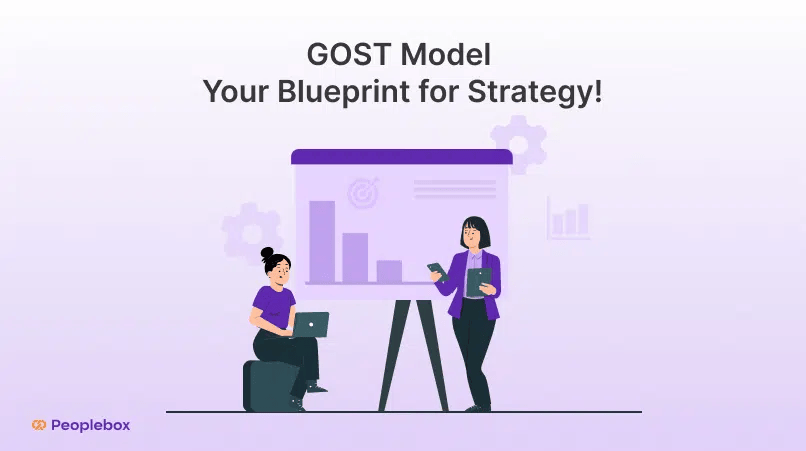The GOST model is a goal-setting model developed by Peter Gollwitzer. The model includes four elements— goals, objectives, strategy, and tactics. By breaking down the process into these four distinct components, the GOST model helps organizations create a actionable plan that aligns with their overall mission and vision.
Goals are the overarching aim that we want to achieve. Objectives are specific and break down the goals into smaller achievable aims. Strategies are the specific plans used to achieve goals and objectives, while tactics are specific actions taken to achieve the goals.
The GOST model can be used in any aspect of your life, both personal and professional. It is a helpful tool because it provides a clear structure for goal setting. It can also help us to identify the best tactics to achieve our objectives.
Now that you understand the GOST Model, let’s learn about the differences between each of the GOST elements.
GOST MODEL: Difference Between Goals, Objectives, Strategy and Tactics?
The Goals
Do you know? According to John Doerr, “ you only achieve 70% of your aspirational goals”.
Goals are the things you want to achieve. They’re specific and measurable, and they’re time-bound. You can have many goals in your life, but only one goal at a time.
A goal should be attainable—meaning it’s possible for you to reach it on a regular basis (such as every day). If your goal is impossible, then it’s not worth pursuing because there’s no point in working so hard for something that won’t happen eventually anyway.
You should also keep in mind that goals should be realistic: if something looks too far away from where you currently stand, don’t try to force yourself through the pain because this will only make things worse! Instead, focus on small improvements along the way until reaching your final destination—and remember: every little step forward counts!
The Rolling Stones best explained goals in one of the tracks “ you can’t get what you want. But if you try sometimes Well, you might find you get what you need”
The Objective
An objective is concrete, enforceable, and defines the progress made towards the objective. It is high-level and aspirational, less about how your company is going to accomplish something and more about what your desired outcome is.
Focus on Goals. Measure your Progress. Achieve Results.
Try Peoplebox to drive exceptional business results.
A purpose is usually a short, generic, clear statement illustrating what your company wants to do, or where they are trying to get to. Goals are broader statements of what the company or organization hopes to accomplish.
Strategy implies a planned campaign of marketing and advertising that will achieve an objective. Your objectives must be the focus while you implement the strategy. Ask yourself what tactics will most effectively help you achieve your marketing goals.
Here is what OKR coach has to say about Objectives:
“The whole point of OKR is: Help your teams solve problems that matter to your business. Decide on the top few problems (That’s your objectives) Define success for these problems ( That’s your Key Results)” – – Richard Russel, OKR Coach
The Strategy
A strategy is a plan of action. It’s the way you’re going to get from point A to point B, and it usually involves a series of steps.
A strategy can be as simple as “I want my business to grow by 20% this year,” or more complex like “I will increase my marketing budget by $15,000 and hire an additional salesperson.”
Strategies are based on goals—the results that you want your business or organization to achieve in order for them to succeed; they’re also based on timeframes—when those results will be achieved (and not how).
Here is what OKR coach has to say about strategy:
“Pivoting in strategy or OKRs get two thumbs up for me as long as it is data driven. Every failure i.e a low score deserves a reflection. Was it due to lack of focus ( too many priorities, too many distractions, too few resources..) poor execution, poor quality of OKRs, or strategy did not work? Iterate the OKR strategy based on the learnings” –Sienam Lulla, OKR Coach
The Tactics
Tactics are the actions you take to achieve your goals. They’re specific and measurable, which means they have an objective and a deadline. Tactics are also easy to measure, so it’s easy for managers and employees alike to see how well they’re progressing toward their objectives.
TACTIC 1: Meetings
Meetings are one of the most common tactics for achieving goals in organizations because they provide an opportunity for all parties involved (managers, employees) to share knowledge about what’s going on in their department or organization as a whole, which can help them work together more efficiently once everyone agrees on where each person stands on issues like budgeting or employee performance reviews.

Here is what the OKR coach has to say about tactics:
“Tactics are the means, but your strategy and the vision it contributes to, are the end.” –Tim Herbig, OKR Expert
How GOST Elements Together Can Lead To Success
How you set your goals, objectives and strategies can make or break your business. Many businesses set goals that are too lofty, without any real strategy or understanding of how they will achieve them. This can lead to disappointment and a feeling of failure, even if the business is actually doing quite well.
Focus on Goals. Measure your Progress. Achieve Results.
Try Peoplebox to drive exceptional business results.
On the other hand, businesses that break their goals down into achievable tactics and take small steps towards them are usually the ones that succeed.
It is important to break your OKR into goals, objectives, strategy, and tactics only after analyzing the problems and the opportunities at your organization.
Putting all of these elements together can lead to success. By setting realistic goals, breaking them down into achievable objectives, and implementing a detailed strategy, you can increase your chances of achieving your objectives and reaching your goals.
Hold a breath! While in a hurry towards success never forget that a goal is not a strategy…
A goal is simply an outcome that your organization wants to achieve as part of its overall strategy. It may also be called a target or end state (depending on context).
You’ll find that many organizations have both short-term and long-term objectives in place when they’re working toward achieving their long-term goals; these are often referred to as “strategic targets” because they help guide strategic thinking over time while also providing direction for day-to-day activities within each department within the larger organization’s structure. Learn more
Conclusion:
In summary, there are several key differences between goals, objectives, strategy, and tactics. While all are important to your success as a manager, they can be used to complete different tasks in your business.
For example, while you may have an overarching goal of increasing revenue by 10 percent each quarter, you may also have objectives that focus more specifically on revenue growth at specific times during the year (e.g., first quarter).
A strategy can be used as a way to achieve multiple objectives (e.g., increasing both revenue and profit), but it also allows for greater flexibility in tailoring tactics based on what is working best for each project or situation.
A tip to remember: there is no “one size fits all” that works for teams to achieve whatever their team desires. If it’s working for some other team, it’s not necessarily that the same formula will also work for your team.
They might have different goals and objectives—on some days approach can be the same but at the end, the desired outcomes will never match. So, take everything we said here with a grain of salt and make sure to test out different strategies until they feel right to you!








